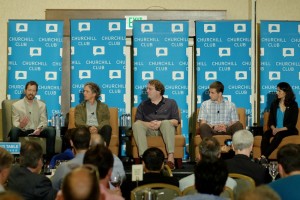 The Churchill Club is a well-respected business and tech forum in the Bay Area, and the conversations that happen there are usually interesting. The club ran a panel on “The Next Frontier” of wearables the other night, featuring execs from Jawbone, Intel, Misfit and Lumo Body Tech.
The Churchill Club is a well-respected business and tech forum in the Bay Area, and the conversations that happen there are usually interesting. The club ran a panel on “The Next Frontier” of wearables the other night, featuring execs from Jawbone, Intel, Misfit and Lumo Body Tech.
Healthcare was repeatedly mentioned as a prime market, both for personal use and as an aid to doctors and other healthcare providers. Yves Behar, Chief Creative Officer at Jawbone, said the real payoff in healthcare will come as more people use wearables and that data is shared as well as collected over a long term.
We have to show that holding people’s data hostage is not a business model
“I think healthcare and research is going to be transformed with millions of people using wearables,” said Behar. He also made the point that using a wearable sensor around the clock is particularly useful because it records heartbeat and sleep patterns over a period of time that can be useful to analyze later.
In his own case, Behar says he has collected over three years of health data using various versions of the Jawbone. “I’ve learned things in the past three years … that I wouldn’t have learned otherwise.” He said he’s “absolutely convinced health and healthcare will be transformed by the analysis of signals embedded into our interactions with wearable products. I think we’re on the right track, but it’s a long windy road to get there.”
When you break the human connection, you’re going to have issues,” said Behar. He compared the issue to the Segway which made its users stand a foot taller than everyone else.
Monisha Perkash, CEO and Co-founder of Lumo Body Tech, warned that the “novelty” of things like activity tracking won’t sustain interest in wearables and advised developers to provide long-term value. “I think wearables are at an inflection point,” she said, “going from a novelty to a necessity and those who will survive will solve real problems in health and wellness, workplace safety and security effectively.”
Perkash said she believes wearable tech will be most successful when it becomes invisible to the user and expects it to be embedded in our clothing collecting all manner of biometric data.
Looking Beyond Google Glass
During a follow-up Q&A session, the panel was asked to comment on the failure of Google Glass.
Behar said one of the biggest barriers to adoption is that as humans we like to communicate with each other and Glass was a technology that got in the way of that. “When you break the human connection, you’re going to have issues,” said Behar. He compared the issue to the Segway which made its users stand a foot taller than everyone else. “That isn’t how people like to communicate.”
Mike Bell, Corporate Vice President and General Manager at Intel, said Glass or something like it could still be successful if the technology becomes more invisible. “It got people talking about privacy and other issues. It was a great experiment,” said Bell. “I think head-mounted technology will be important in the future.”
Get Off the Phone
There was also discussion of what the ‘killer app’ for wearables might be. Behar said it’s going to be something that gets people to use their smartphones less. “The killer app for me is getting people off the phone. Having our heads off the display is a big issue.”
As an example, Behar is founder and CEO of fuseproject, an integrated design and branding firm that among other projects created the August smart lock. The August automatically unlocks the door as the (authorized) user approaches the door. That’s it, no other interaction required.
Perkash sees a big future in wearable or sensor tech embedded in clothing including fun applications like gaming where the user’s body is the game controller moving an avatar through different scenarios, for example. As her company focuses on posture, she’d like to see an app that shuts off if you slouch.
All the panelists agreed devices have to be aesthetically pleasing to succeed.
“From a geeky perspective this is the most difficult thing I’ve ever done,” said Bell who was formerly an executive at Palm and also worked at Apple. “A wearable has to look good, it can’t be ugly, and it has to be captivating and useful out of the box or it ends up in the drawer.”
Bell also thinks the current “duopoly” of Android and iOS in phones will not, ultimately, carry over to wearables and there will be room for a lot of players. “Everyone doesn’t want to wear the same thing as everyone else,” he said.
Also, because we may end wearing many different devices they will have to stay powered for long periods of time or easily recharged. “You don’t want to be plugging your shoes in at night,” he joked. “We’ll be able to power off motion or heat or something else.”
He also called on the tech community to promote new business models. “We have to show that holding people’s data hostage is not a business model. We need to solve this (issue of interoperability) for the people buying these devices.”